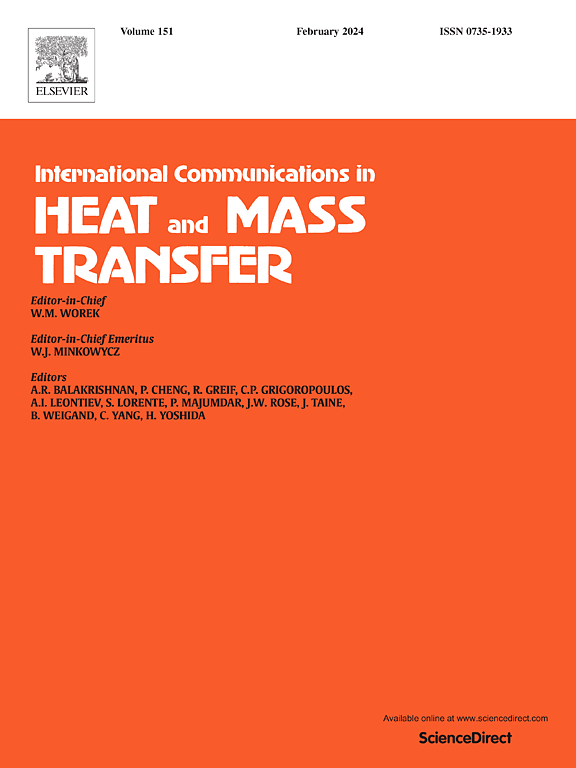The numerical study on flow and heat transfer performance of convergent swirl cooling chamber roughed with different dimples in turbine blade leading edge
IF 6.4
2区 工程技术
Q1 MECHANICS
International Communications in Heat and Mass Transfer
Pub Date : 2025-05-29
DOI:10.1016/j.icheatmasstransfer.2025.109137
引用次数: 0
Abstract
This paper focuses on the internal cooling structure of the gas turbine blade leading edge, aiming to promote the heat transfer performance of the swirl cooling channel (SCC) inner walls by adding dimple structures to those walls. The study compares and analyzes the flow and heat transfer characteristics of the straight smooth swirl cooling channel, the smooth converging swirl cooling channel and the converging swirl cooling channels with spherical dimples, 45° oblique dimples as well as 60° oblique dimples. Numerical simulations were conducted to investigate the impact of different wall temperatures, inlet Reynolds numbers and channel wall structures on the heat transfer performance of the internal swirl cooling channel of the blade leading edge. The computational results indicate that among all dimple structures studied in this work, spherical dimples exhibit superior heat transfer performance, with an average wall Nusselt number 21.16 % higher than that of the converging swirl cooling channel without dimples. For different swirl cooling channels in this work, the front surface average Nusselt number tends to ascend with an increasing inlet , and the rate of ascent diminishes as the increases. As the inlet Reynolds number increases from 10,000 to 100,000, for these 5 different swirl cooling channels, the front surface average Nusselt number increases by 508.29 %, 442.58 %, 478.75 %, 472.48 %, and 483.41 %, respectively. As the wall temperature is increased from 30 °C to 70 °C, the heat transfer effect is only enhanced by 4.22 %. Although we newly proposed decorating the convergent swirl cooling channel with the oblique dimple to try to achieve higher heat transfer performance, the overall results show that the spherical dimple roughed swirl cooling channel shows higher heat transfer performance and lower pressure loss than the 45° and 60° oblique dimples. When designing the internal cooling channels of the turbine blade leading edge, if a converging swirl cooling structure is adopted, it is recommended to consider decorating the spherical dimples to the swirl channel wall as heat transfer enhancement structures.
涡轮叶片前缘不同韧窝粗糙的会聚旋流冷却室流动与换热性能的数值研究
本文以燃气轮机叶片前缘的内部冷却结构为研究对象,通过在旋流冷却通道内壁上增加凹窝结构来提高其换热性能。对比分析了直线光滑涡流冷却通道、光滑收敛涡流冷却通道以及带球面凹窝、45°斜凹窝和60°斜凹窝的收敛涡流冷却通道的流动和换热特性。通过数值模拟研究了不同壁面温度、进口雷诺数和通道壁面结构对叶片前缘内旋流冷却通道换热性能的影响。计算结果表明,在本文研究的所有凹窝结构中,球形凹窝具有较好的换热性能,其平均壁面努塞尔数比不含凹窝的会聚涡流冷却通道高21.16%。对于不同的旋流冷却通道,前表面平均努塞尔数随入口Re的增加呈上升趋势,上升速率随入口Re的增加而减小。当进口雷诺数从10000增加到100000时,5种不同的涡流冷却通道前表面平均努塞尔数分别增加了508.29%、442.58%、478.75%、472.48%和483.41%。当壁面温度从30℃升高到70℃时,传热效果仅提高了4.22%。为了获得更好的换热性能,我们提出了用斜凹窝装饰汇聚涡流冷却通道的新方法,但总体结果表明,与45°和60°斜凹窝相比,球形凹窝粗糙涡流冷却通道具有更高的换热性能和更低的压力损失。在设计涡轮叶片前缘内部冷却通道时,如果采用会聚旋流冷却结构,建议考虑在旋流通道壁上装饰球形凹窝作为强化传热结构。
本文章由计算机程序翻译,如有差异,请以英文原文为准。
求助全文
约1分钟内获得全文
求助全文
来源期刊
CiteScore
11.00
自引率
10.00%
发文量
648
审稿时长
32 days
期刊介绍:
International Communications in Heat and Mass Transfer serves as a world forum for the rapid dissemination of new ideas, new measurement techniques, preliminary findings of ongoing investigations, discussions, and criticisms in the field of heat and mass transfer. Two types of manuscript will be considered for publication: communications (short reports of new work or discussions of work which has already been published) and summaries (abstracts of reports, theses or manuscripts which are too long for publication in full). Together with its companion publication, International Journal of Heat and Mass Transfer, with which it shares the same Board of Editors, this journal is read by research workers and engineers throughout the world.

 求助内容:
求助内容: 应助结果提醒方式:
应助结果提醒方式:


